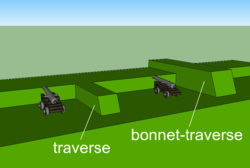Traverse (fortress construction)
As Traverse (. Of double traverse , "cross-bar") or Zwerchwall (transverse wall) will be referred to a short fortification Wall transversely to another Wall - but in particular to a parapet - runs. In military parlance, the term is often applied to various measures in field fortifications that divide elongated fighting positions or trenches into several sections in order to cover them against flanking longitudinal fire or to limit the fragmentation effect in the event of grenade impacts to the shortest possible sections.
About the function of trusses
When the artillery began to play an increasingly effective role in the siege of fortifications, as early as the middle of the 16th century people were forced to follow the long straights of the " covered path " with successively staggered angles or through short transverse walls in several sections subdivide in order to weaken the effect of enemy artillery. A little later, it was also decided to secure the cannon placements standing free on the ramparts, only covered by a parapet, against flank fire by means of transverse ramparts. The main task of trusses is therefore to cover troops standing on the parapet against flank or rear fire.
Full trusses
Under full traverses one understands cross walls that consist entirely of earth or masonry. The erection of such trusses on the ramparts became inevitable when the siege artillery under Marshal Vauban began to coat the ramparts lengthways with special rikoschett batteries. To do this, Vauban systematically used the technique of rikochetting for the first time , in which the cannonball after the first impact - like a stone thrown flat on the surface of the water - jumped open several times before it came to rest. In the process, she killed or damaged everything in her way. In this way, the attackers were able to clear several pieces of artillery or artillery out of the way with one shot. To prevent this, earth walls were built between the individual gun positions (usually one or two guns). These walls also served to impair the effectiveness of the “bombs” ( grenades ) fired by mortars .
Hollow trusses
In 1720, Colonel Buggenhagen from Mecklenburg erected brick traverses for the first time, which were covered by earthworks (on the wall) and served as log houses or (in the covered path) as small capons . Shortly thereafter, there was a general move towards building in traverses, mostly arched cavities, which were completely covered with earth on the outside (on the enemy side) and had one or more entrances to the fixtures on the inside (on the fortress side). These so-called “ hollow trusses ” could have different sizes. They mostly served as shelters to protect the troops deployed on the wall or as magazines for equipment and ammunition. Until the 19th century, additionally with were like loopholes provided hollow trusses as a guard and observation posts on the Saillant asked (the tip) of bastions.
Main or capital trusses
To protect against flank or rear fire, transverse walls were later built inside a fortress, which also wanted to avoid having to "excessively" raise the main wall. Such a wall, which runs across a fortress, is called a main traverse . If two such capital trusses are placed in a hill or a fort , which intersect at right angles in the middle of the work, one speaks of a cross truss . Especially during the 19th century, not infrequently entire buildings (especially magazines and workshops, in some cases even barracks with entrances and windows to the protected inner courtyard) and the main connecting routes (" posterns ") of a fortress were relocated in one of the capital traverses These were transformed into "bomb-proof rooms" by the massive earthenfills, for example the complete transverse construction at the southern end of the fortress courtyard of the Ehrenbreitstein Fortress , which was supposed to prevent direct fire on the courtyard from the opposite height of the Karthauser mountain, but remained without earthfill due to the terrain. The free-standing masonry is equipped with cannon slots.

Wall trusses
When forts were newly built in the 19th century, long straight lines were created that were covered by a crenellated wall . In order to prevent the flanking fire by enemy troops, who had overcome the wall at one point, for example through a breach, short walls were drawn at certain intervals across the longitudinal direction (from the crenellated wall into the wall). They were provided with a passage that could be closed with an iron-studded door. This type of crossbar was equipped with loopholes and thus set up for close defense. Also in the underground passages, the so-called posternes, there are traverses that barred this passage against invading enemies (for example in Fort Douaumont )
The traverses made of sandbags in trenches served the same purpose if, for whatever reason, they could not be laid in a zigzag.
gallery
Fort de Comboire with three hollow crossbars and one full crossbar
literature
- Hartwig Neumann : Fortress architecture and fortress construction technology. German defense architecture from the 15th to the 20th Century. With a bibliography of German-language publications on fortress research and fortress use 1945–1987. (= Architectura militaris 1). 2nd edition, special edition. Bernard & Graefe, Bonn 1994, ISBN 3-7637-5929-8 .
Notes and individual references
- ↑ In Central European fortress construction, this height is the normal form
- ^ Bernhard von Poten : Concise dictionary of the entire military sciences. 1878, sv traverses
- ↑ Engels in: The New American Cyclopædia. 1859, sv Fortification; Riistow: Military concise dictionary. 1858, sv Traverse
- ↑ Engels in: The New American Cyclopædia. 1859, sv Fortification; Zastrow: History of the permanent fortification. 1839, p. 106
- ^ Bernhard von Poten : Concise dictionary of the entire military sciences. 1878, sv hollow trusses
- ^ Riistow: Military concise dictionary. 1858, sv Traverse
- ^ Riistow: Military concise dictionary. 1858, sv Traverse
- ↑ actually "passage"





